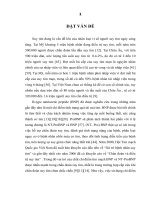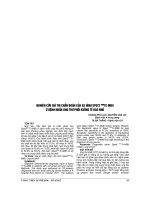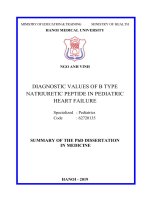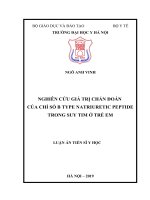Nghiên cứu giá trị chẩn đoán của chỉ số b type natriuretic peptide trong suy tim trẻ em tt tiếng anh
Bạn đang xem bản rút gọn của tài liệu. Xem và tải ngay bản đầy đủ của tài liệu tại đây (605.21 KB, 28 trang )
MINISTRY OF EDUCATION & TRAINING
MINISTRY OF HEALTH
HANOI MEDICAL UNIVERSITY
NGO ANH VINH
DIAGNOSTIC VALUES OF B TYPE
NATRIURETIC PEPTIDE IN PEDIATRIC
HEART FAILURE
Specialized : Pediatrics
Code
: 62720135
SUMMARY OF THE PhD DISSERTATION
IN MEDICINE
HANOI - 2019
Dissertation is completed at:
HANOI MEDICAL UNIVERSITY
Scientific supervisors :
1. Prof. Le Thanh Hai
2. Associate Prof. Pham Huu Hoa
Debater 1:
Debater 2:
Debater 3:
The dissertation will be defended with the Committee at Hanoi
Medical University.
At:
hour
min, day month year 2019.
Assess the thesis at the library:
- Vietnam National Library
Hanoi Medical University’s Library
3
RE
Heart failure is defined as a clinical syndrome characterized by
typical symptoms such as dyspnea, low extrimeties edema, and fatigue.
This may be accompanied by several signs such as distended jungular,
crackles and peripheral edema caused by structural or functional cardiac
abnormalities, resulting in reduced cardiac output or high intracardiac
pressure during rest or exertion.
Heart failure causes many dangerous complications, even death if
not diagnosed early and treated promptly. However, it is difficult to
diagnose heart failure in children, especially newborns and infants,
because symptoms are often discreet and non-specific. Therefore,
finding an early, easy-to-follow and accurate method of diagnosis is
essential for pediatricians.
In recent years, the role of biomarkers such as B-type sodium
diuretic peptide (BNP, NT-ProBP) in the evaluation of heart failure in
adults has been confirmed. Studies in adults have shown that serum NTProBNP concentration is strongly correlated with cardiac function and
heart failure classes. Currently, there is no adequate and systematic
assessment of the role of NT-proBNP in Vietnam. Heart failure in
children. To better understand this issue, we conducted the study:
"Diagnostic value of Natriuretic Peptide type B concentration in
heart failure in children" with 2 objectives:
1. To determine serum NT-ProBNP concentration in heart failure in
children.
2. Study the value of NT-ProBNP in diagnosis, monitoring, treatment
and prognosis of heart failure in children.
4
CHAPTER 1. OVERVIEW
1.1. Pediatric heart failure
1.1.1. Pathophysiology
Preload
Heart rate
Cardiac
output
Stroke volume
Afterload
Figure 1.1. Influenced factors of cardiac output
1.1.2. Classification
- Location: left-sided, right-sided, and biventricular heart failure
- Progession: acute and chronic heart failure
- Function: systolic and diastolic heart failure
- Cardiac output: low-output and high-output heart fialure
- Ejection fraction: heart failure wwith decreased, borderline or
preserved ejection fraction
1.2. Diagnosis
Based on physical examination, history and investigation tools
1.2.1. Physical examintion
Signs and symptoms of heart failure are the manifestions off low
cardiac output and congstion in other organs. Typical signs and
symptoms are: tachycardia, dyspnea, hepatomegaly, and decreased
physical activities.
5
1.2.2. Investigation
Chest x-ray, electrocardiogram, and echocardiography are main
investigation tools in diagnosis of heart failure. Echocardiography
provides information about structure and sizes of heart chambers, and
assesses cardiac function, especially left ventricular function include:
fractional shortening (FS), ejection fraction (EF).
Nowadays, role of biomarkers, especially B-type natriuretic
peptides (BNP, NT-proBNP) in diagnosis of heart failure is emerging
and shows high sensitivity and specificity.
1.2.3. Diagnosis of heart failure according to the modified Ross
standard
Modified Ross criteria include: diaphoresis, tachypnea, breathing
patterns, respiratory rates (RR), heart rates (HR) hepatomeagaly.
Diagnosis are made when grades are more than 2 points with severity
from mild to severe (3-12 points) (Table 1.1)
Point
History
Table 1.1. Modified Ross criteria
0
1
2
Rare
Head and body at
exertion
Occasionally
Đầu và thân
khi nghỉ ngơi
Frequent
Normal
Retractions
Dyspnea
< 50
< 35
< 25
< 18
50 - 60
35 - 45
25 - 35
18 - 28
> 60
> 45
> 35
> 28
< 160
< 105
< 90
< 80
160 - 170
105 - 115
90 - 100
80 - 90
> 170
> 115
> 100
> 90
<2
2-3
>3
Diaphoresis
Head only
Tachypnea
Examination
Breathing
RR
0 - 1 years
1 - 6 years
7 - 10 years
11 - 14 years
HR
0 - 1 years
1 - 6 years
7 - 10 years
11 - 14 years
Hepatomegal
y
6
Advantages of modified Ross criteria: simple signs and symptoms,
easy to determine and assess exactly heart failure in all ages.
1.2.4. Grading
- Signs and symptoms (classic)
- Grading: NYHA
- Staging: AHA/ACCF
- PHFI scoring
- Modified Ross criteria
Modified Ross criteria is applied in children and have 4 grades (Table 1.1):
- I: 0-2 points: no heart failure
- II: 3-6 points: mild
- III: 7-9 points: moderate
- IV: 10-12 điểm: severe
1.3. Overview of B-type natriuretic peptides
1.3.1. Source, structure
Precursor of NT-proBNP is pro-pre-peptide including 134 amino
acids. 26 amino acids were removed and peptide became prohormone
BNP called proBNP1-108 with 108 acid amin. Afterthat, proBNP1-108
was split by hydrolytic enzymes (furin and corin) into two parts:
terminal part include 76 amino acids (NT-proBNP1-76) without
bioactivity and a molecule including 32 amino acids (BNP1-32) with
bioactivity. NT-ProBNP and BNP are named B-type natriuretic peptides
7
Figure 1.2. Structure of B-type natriuretic peptides
1.3.2. Mechanism of serum NT-ProBNP release and clearance
NT-proBNP is mostly released by ventricular muscle when
pressure and volume increase in heart chambers, especially left
ventricle. Therefore, NT-proBNP is a sensitive and specific biomarker
for ventricular dysfunction.
NT-proBNP is excreted by kidney and NT-proBNP serum
concentration is inversely proportional with glomerular filtration rate.
NT-proBNP half-life is 120 minutes.
1.3.3. Quantitative measure of Serum NT-proBNP
NT-proBNP is measure by electroluminescene method and
automatic device were widely used.
In electroluminescene method, NT-proBNP was measured by
combining with sampled antigen with specific antibody of NT-proBNP
(Sandwich method). Measured sample is serum or plasma
anticoagulated by li-heparin or K2, K3-EDTA. Cross-reaction with antiserum of Aldosteron, ANP28, BNP32, CNP22, Endothelin, và
Angiotensin I, Angiotensin II, Angiotensin III, Renin, NT-proANP are
<0,001%. Detection limit of this method is 5 pg/mL.
1.3.4. NT-proBNP serum concentration in children and inffluenced
factors
In children, NT-proBNP concentration varies throughout
deve;opmental stages, esspecially in neonatal period. NT-proBNP
concentration rise strongly in the first 48 hours and drop quickly after 2
weeks. After neonatal period, studies showed that NT-proBNP
continued to drop and became stable in 4-15 months.
Influenced factors to NT-proBNP include renal insuffiency, sepsis,
shock, respiratory distress, obesity, severe anemia,…
1.4. Management
- Medical therapy
First choice for patient with decreased ventricular systolic function
- Invasive therapy
Indication for severe heart failure refractory to medical therapy,
include 2 options: mechancal devices and heart transplant
- Treat the etiology and precipitated factors
8
- Nursing care and nutrition
CHAPTER 2
SUBJECTS AND METHODS OF RESEARCH
2.1. Research subjects
408 children at the National Hospital of Pediatrics, divided into 2 groups:
Diseases
group:
136
heart
failure
children
- Control group: 272 children did not suffer from cardiovascular
diseases of the same age and gender with the disease group.
- From April 2013 to October 2018.
2.1.1. Inclusion criteria
Diseases group (heart failure)
- Children with cardiovascular disease were identified based on clinical
examination, chest X-ray, electrocardiography, echocardiography and
with 3 or more points according to Ross modified standards (Table 1.1)
Control group
- Children without cardiovascular disease were identified based on
echocardiography, electrocardiography, chest X-ray and no heart failure
according to the modified Ross standard.
- Children did not suffer from respiratory failure and circulatory failure.
2.1.2. Exclusion criteria (both disease group and control group)
- Kidney failure
- Endocrine disease
- Severe infections
- Pneumonia
- Obesity
- Severe anemia
2.2. Research Methods
2.2.1. Research design
- Research of prospective, cross-sectional description with
comparison.
2.2.2. Sample size
2.2.2.1. Research group
9
To select the sample size for the study of diagnostic value using the
ROC curve, we apply a sample size formula:
-
- n is the number of heart failure patients
- = 1.96 with 95% confidence
- d: expected error
- AUC: area under the curve
V(AUC) = (0,00099 x ) x (6a2 +16)
a = φ-1(AUC) x 1,414
- φ is the inverse function of the standard cumulative
distribution function of the AUC.
Based on the study of Chun-Wang Lin (2013), the area under the
AUC curve in children 1-3 years old is 0.786 and takes d = 0.06, instead
of the formula we have:
-1
n = = 132,6
In the study, we took 136 patients to satisfy the sample size
requirement.
2.2.2.2. Control group
The number of children in the control group should be collected
based on the number of heart failure patients in the proportional study:
the disease is 2: 1. Corresponding to 1 heart failure patient we selected
2 control group patients with the same age and sex. With the sample
size of heart failure group of 136 patients, we selected 272
corresponding control children.
2.3.3. Steps to conduct research
Heart failure patients
Patients hospitalized at the ER had been asked about the history of
disease, clinical examination and laboratory tests as follows:
Clinical examination
Evaluate symptoms and degree of heart failure follows the modified
Ross standard.
10
Investigations
- Laboratory tests
Collect blood samples to quantify the NT-proBNP concentrations
in serum at the time of admission of patients to the Emergency
Department. Time of sampling points at least 1 hour after the patient
hospitalized and did not been given any treatment. With patients who
had
congenital
heart surgery,
we
measured NT-proBNP
concentrations at 24 hours after surgery.
- Chest X-ray and electrocardiogram
- Echocardiography:
evaluation of
left ventricular
ejection
fraction (EF).
Assess progress after treatment
Before discharge, patient progression after treatment is assessed
and divided into levels: good progress, bad or death.
Control group
Quantify serum NT-ProBNP levels at the time the child arrives at the
clinic without any treatment.
CHAPTER 3
RESULTS
3.1. General characteristics of the subjects
In the period from April 2013 to October 2018, we selected 136
patients who were qualified to enroll in the study.
3.1.1.
Age, sex distribution
Table 3.1. Age and sex distribution of the subjects
CHF group
Control group
Age, sex
n
%
n
%
Male
65
47.8
130
47.8
Female
71
52.2
142
52.2
Total
136
100%
272
100%
< 1 year old
62
45,6
124
45,6
1 - <5 years old
39
28,7
78
28,7
5 -15 years old
35
25,7
70
25,7
Age (month)
14 (4 – 72)
14 (4 – 72)
(Median, IQR)
11
Comment:
- In both CHF and control groups, the youngest was 1 day old, the
oldest was 15 years old, mainly seen under-1-year-old subject (45.6%).
- In both groups, boys accounted for 47.8%, girls accounted for 52.2%,
there was no statistical significance (p >0.05).
Myocarditis
dilated cardiomyopathy
C
Others
Figure 3.1. Etiological distribution of CHF
Comment: Myocarditis is the most common disease, accounted for 37.5%,
second is dilated cardiomyopathy (25%) and congenital heart disease
(22.1%).
3.2. Serological NT-ProBNP concentration of the subjects
3.2.1. Serological NT-ProBNP concentration in control group
Table 3.2. Distribution of NT-ProBNP concentration according to sex
and age
n (%)
NT-ProBNP
Characteristic
p
(Median; IQR)
Male
130 (64.6%)
31 (19-59,4)
Sex
> 0,05
Female
142 (35.4%)
32 (19-56,1)
Age
< 1 month old
12 (4.41%)
139 (89 -157)
1 - < 3 months old
13 (4.78%)
82 (41-109,5) < 0.05
3 - <12 months old
100(36.8)
51 (32 - 79)
1 - <5 years old
76 (27,9%)
22,5 (16-41,7) >0.05
12
5 - 15 years old
Total
71 (26,1%)
272
21(12,5-39,4)
31 (19-57,6)
Comment:
Age
- The median value of NT-ProBNP concentration of the control group
is 31 pg/mL
- Serological NT-ProBNP concentration is highest in under one month of
age subjects then decreased with age and remains stable after 1 year of age.
Sex
- There is no difference in NT-proBNP concentration between sexes
(p>0.05).
Age
Figure 3.2. Correlation between NT-ProBNP concentration and age
Comment:
- NT-ProBNP concentration decreased with age and had a inverse
linear correlation between the 2 parameters (r = 0.352; p <0.05)
3.2.2.
3.2.2.1.
Serological NT-ProBNP concentration in CHF group
NT-ProBNP with the severity of heart failure
Table 3.3. NT-ProBNP concentration with levels of heart failure
NT-ProBNP (pg/ml)
Severity
n (%)
P
Median (IQR)
Mild
36
361 (164 - 621)
<
(26.5%)
0.01
Moderate
49 (36%)
2394 (1381- 4096)
Severe
51
4138 (3463-7297)
13
Total
(37.5%)
100
(100%)
2778 (708-4138)
Comment:
- The NT-ProBNP concentration increased with stages of heart failure,
with the highest in severe severity and lowest in mild severity.
- The difference of NT-ProBNP concentration in the severity of heart
failure is statistical significance (p< 0.01).
Point of Ross
Figure 3.3. Correlation between NT-ProBNP and heart
failure cut-off point
Comment:
- NT-ProBNP concentration has a positive linear correlation with point
of heart failure (Point of Ross) (r = 0.84, p <0.001).
3.2.2.2.
The correlation between NT-ProBNP concentration with the
etiology
Table 3.4. Correlation between NT-ProBNP concentration and the
etiology
NT-ProBNP (pg/mL)
Disease
n (%)
p
Median (IQR)
51
< 0.01
Myocarditis
4138 (366 - 23541)
(37.5%)
Dilated
34
2669 (811 – 4733.5)
cardiomyopathy
(25%)
Congenital heart
30
380 (172 - 2374)
disease
(22.1%)
21
Others
2091 (706 - 3977)
(15.4%)
Total
136
2778 (708-4138)
14
(100%)
Comment:
- As for the etiology of heart failure, the NT-ProBNP concentration is
highest in myocarditis (4138 pg/mL), lowest in congenital heart disease
(380 pg/mL).
- The difference of NT-ProBNP concentration between the diseases is
statistical significance (p<0.01).
3.2.2.3.
NT-ProBNP concentration and left ventricular ejection fracture (EF)
EF
Figure 3.4. Correlation between NT-ProBNP concentration and EF
Comment:
- The NT-ProBNP concentration has an inverse linear correlation with
left ventricular ejection fracture (EF) (r = 0.428; p <0.001).
3.3. The value of NT-ProBNP in the diagnosis, follow-up and prognosis
of heart failure in children
3.3.1.
The value of NT-ProBNP in the diagnosis of heart failure
3.3.1.1.
The correlation between NT-ProBNP concentration of CHF
and control groups
15
CHF
Preserved EF
mild CHF
control group
Figure 3.5. Comparison of NT-ProBNP between CHF and control
groups
Comment:
- The NT-ProBNP concentration in CHF group is higher than in control
group. This is statistical significance (p < 0.001).
- The NT-ProBNP concentration both in CHF group with preserved EF
and mild CHF group are higher. This is statistical significance (p < 0.001).
3.3.1.2.
Cut-off point of NT-ProBNP in the diagnosis of heart failure
- Cut-off: 314,5 pg/ml
- Sensitivity: 88,2%
- Specificty: 66,7%
- AUC: 0,810 (0,710 - 0,909)
Figure 3.6. ROC curve in the diagnosis of heart failure
Comment:
The optimal cut-off point of NT-ProBNP is 314.5 pg/mL, it has a
role in borderline determination between hear failure (mild to severe)
and non heart failure for all ages with the sensitivity of 88.2% and
16
specificity of 66.7%, the area under the ROC curve is 0.81 (0.71 –
0.909).
3.3.1.3.
NT-ProBNP in the diagnosis of left ventricular systolic dysfunction
Figure 3.7. The correlation between NT-ProBNP and left vent
ejection fracture
Comment:
- In CHF group, the elevated NT-ProBNP concentration in non systolic
dysfunction patients (EF > 50%) has statistical significance in comparison
with systolic dysfunction patients (preserved EF) with p < 0.001.
- Cut-off: 672,5 pg/ml
- Sensitivity: 92.9%
-
Specificty: 53.6%
- AUC: 0.781
(0.7
0.858).
Figure 3.8. ROC curve in the diagnosis of left ventricular systolic
dysfunction
With the optimal serological NT-ProBNP cut-off point of 672.5
pg/mL, it has a role in the borderline determination between systolic
17
dysfunction (EF < 50%) and non dysfunction (EF > 50%) with the
sensitivity of 92.9% and the specificity of 53.6%, the area under the
ROC curve is 0.781 (0.704 – 0.858).
3.3.2.
The value of NT-ProBNP in the follow-up and prognosis of
heart failure in children
3.3.2.1.
The correlation between NT-ProBNP and the results of heart
failure treatment.
p<0,05
p<0,05
4138
4138
2329
bad progression
Good progression
2374
mortality group
non-mortality group
Figure 3.9. The correlation between NT-ProBNP concentration and
treatment results
Comment:
- The median of NT-ProBNP concentration of bad progression is
4138 pg/mL, higher than good progression (2329 pg/mL) with p < 0.05.
- NT-ProBNP concentration in mortality group is higher than nonmortality group (median 4138 and 2374, respectively) with p <0.05.
3.3.2.2.
Cut-off point of NT-ProBNP in the prediction of treatment
outcome
Good-bad progression
With the optimal serological NT-ProBNP concentration cut-off
point of 2778 pg/mL, it has a role in the borderline determination
between good and bad progression after treatment with the sensitivity of
18
72.6% and specificity of 80%, the area under the ROC curve is 0.802
(0.707 – 0.897)
Mortality prognosis
With the optimal serological NT-ProBNP cut-off point of 5015
pg/mL, it has a role in the borderline determination between mortality
and non mortality with the sensitivity of 76,3%, and specificity of
68,2%, the area under the ROC curve is 0,814 (0,733 - 0,896).
3.3.2.3.
Role of NT-ProBNP in mortality prognosis
During the multivariate logistic regression analysis, we notice that
factors during admission: NT-ProBNP concentration, systolic ejection
fracture (EF), severity of heart failure are associated with mortality.
Table 3.5. Optimal predictive model of mortality prognostic factors
Factor
OR
CI 95%
p
Severity
7.363
2.003 – 27.067
< 0.05
EF (%)
0.941
0.889 – 0.995
< 0.05
NT-ProBNP (pg/ml)
1.021
1.004-1.152
< 0.05
Comment:
- The higher the severity, the greater risk of mortality, with OR = 7.363;
95% CI (2.003 – 27.067).
- The lower the EF, the greater risk of mortality (OR = 0.941; 95% CI
(0.889 – 0.995).
- The higher the NT-ProBNP, the greater risk of mortality, with OR=1,021,
95 CI (1,004-1,152).
3.3.2.4.
The role of NT-ProBNP in the prognosis of congenital cardiac
surgery
19
Figure 3.10. The correlation between NT-ProBNP before surgery and
treatment prognostic factors
Comment:
The NT-ProBNP concentration before surgery has positive linear
relationship with length mechanical ventilation (r= 0.645; p <0.001),
length of stay in ICU (r= 0.576, p<0.001) and duration of inotropic
support (r=0.516, p<0.06).
Figure 3.11. The correlation between 24-hour-post-surgery NTProBNP and treatment prognostic factors
Comment:
The NT-ProBNP concentration at 24-hour post surgery has a
positive linear relationship with length mechanical ventilation (r=
0.421; p <0.02), length of stay in ICU (r= 0.394, p<0.031) and duration
of inotropic support (r=0.396, p<0.029).
DISCUSSION
4.1. General characteristics of the research group
20
4.1.1. Age and gender
- Age:
In the study, the hospital admission age of the heart failure
group was the most common age of less than 1 year, accounting for
45.6% (Table 3.1). Author of Massin M et al also made the comment
similar to that of heart failure in children primarily occurs in the first
year of life.
- Gender:
In the study, the rate of heart failure in boys was 47.8%, female
52.2% and there is no difference between genders (p > 0.05) (Table
3.1). Similarly, Chong Shu-Ling et al also showed that in children there
is no difference in the incidence of heart failure among boys and girls.
4.1.2. Distribution of causes of heart failure
The results of our study show that the distribution of causes of
heart failure is as follows: myocarditis accounts for the highest rate
(37.5%), followed by dilated cardiomyopathy (25%) and congenital
heart diseases are 22.1%.
In children, studies have shown that the causes of heart failure are
different from adults. In adults, the causes of heart failure are mainly
caused by high blood pressure, coronary artery disease, heart
valves, ... About the distribution of causes of heart failure by age, we
found that in myocarditis group, onset ages primarily in older children
with ages from 5 to 15 years (accounting for 39.2%). In congenital heart
diseases group, we mainly have patients under 1 year old, accounting
for 43.5 %. Other studies in children with heart failure have also shown
that myocarditis usually found in older children, while congenital heart
mainly occurs in the group under 1-year-old.
4.2. Serum NT-ProBNP concentration in the study group
4.2.1. NT-proBNP N concentration of serum of the control group
The results of our study showed that the median value of NTProBNP levels of the control group was 14 pg/ml, IQR (9-31.6) pg/ml
(Table 3.2). Other studies also provide various values of proBNP
concentration of healthy children or children who do not suffer from
heart diseases.
Author
Table 4.1 NT-proBNP level in control group of studies
NT-ProBP (pg / ml)
Sample size
Ages
Median ( IQR )
21
Our study
272
1 month - 15 years
14 (9-31.6)
old
Ralf Geige
102
1 month - 18 years
76.7 (35 -122.4)
old
Cohen
13
1 - 36 months
89 (88 - 292)
Jakob A Hauser
89
2 - 15 years old
66 (23–105 )
The difference in control NT-ProBNP concentrations among the
authors is due to the incompatibility of age and sample size between
studies. In addition, according to us, other studies have not eliminated
the factors that can increase NT-ProBNP levels such as anemia,
pneumonia, obesity ...
4.2.1.1. Serum NT-ProBNP concentration of the control group by age
Results of our study showed that NT-ProBNP concentration of
control group was inversely correlated with age (r = - 0.352; p <0.05)
(Figure 3.2 ). This result shows that this index decreases with age,
meaning that the higher the age, the lower the concentration of NTProBNP and vice versa. Overseas studies on healthy children or
children without cardiovascular disease have made similar
comments. According to Table 3.2, we find that the concentration of
NT-ProBNP increases in the neonatal period then decreases after this
age of age and stabilizes after 1 year.
4.2.1. 2. Serum NT-ProBNP concentration of the control group by sex
In the control group, we found no difference between the sexes
about serum NT-ProBNP levels. Median values in boys were 14 pg / ml,
IQR (9-33.5) pg / ml, female 15 pg / ml , IQR (9-30.5) pg / ml and the
difference was not statistically significant (p> 0.05) ( Table 3.2 ). Other
studies have made similar observations when showing NT-ProBNP
levels in healthy children with no gender difference [115]. According
to author Nir A , NT-proBNP levels in healthy children under the age of
13 are not different between the sexes. After this age, the concentration
of NT-proBNP in boys is lower than that of girls, which may be related
to estrogen levels (activation of diuretic peptide synthesis genes) and
androgen (reducing diuretic peptid concentration )...
22
4.2. 2. Serum NT-ProBNP concentration of heart failure group
4.2.2.1. Value of NT-ProBNP concentration of heart failure group
The results showed that serum NT-ProBNP levels of heart failure
group had median values of 2778 pg/ml, IQR (708-4138)
pg/ml (Table 3.3). Other studies also show different values for NTProBNP levels in children with heart failure. The concentration of NTProBNP in children with heart failure varied among the authors
according to us, due to the heterogeneity between the study populations
as to the age distribution, the conditions causing heart failure as well as
the degree of impairment. heart.
4.2.2 .2. Correlation between NT-ProBNP levels and the degree of heart
failure and heart failure
The study results showed that the concentration of serum NTProBNP increased corresponding to the level of mild to severe heart failure
with significant difference (p <0.01) (Table 3.3.) . Similar to Diagram 3.3,
we found that NT-ProBNP concentrations were positively and closely
correlated with heart failure points (r = 0.84, p <0.001).
When compared with the causes of heart failure, the results showed
that the concentration of NT-ProBNP was very high in the group of
myocarditis, which was higher than other diseases such as dilated
cardiomyopathy, congenital heart disease. This suggests that in rapid
and sudden onset of heart failure, the concentration of NT-ProBNP is
higher than that of the chronic progressive group.
In acute heart failure, the increase in pressure, as well as cardiac
volume, rapidly occurs, and sudden onset t is the trigger that leads to a
rapid increase in the concentration of NT-ProBNP.
4.2.2.3. Correlation between
ventricular ejection fraction
NT-ProBNP
concentration
and
left
The results in Figure 3.4 show that NT-proBNP concentration
is negatively correlated with left ventricular ejection fraction (p <0.001,
r = - 0.428). This suggests that, for children with heart failure with
23
reduced left ventricular systolic function, serum NT-ProBNP
concentration increases accordingly and vice versa. Other authors have
made similar comments and believe that NT-ProBNP levels play an
important role in assessing left ventricular dysfunction in children.
4.3. Serum TN-ProBNP concentration values in diagnosis and prognosis
for heart failure treatment
4.3.1. Serum NT-ProBNP concentration value in the diagnosis of heart failure
4.3.1.1. Comparison of NT-ProBNP concentration of heart failure group
with the control group
When comparing between the heart failure group with the control
group, through Chart 3.5 we found that the median concentration of NTproBNP in the heart failure group was 2778 pg/ml, significantly higher
than the control group (14 pg/ml) and its statistical significance with p <
0.001. In addition, in children with mild heart failure or heart failure
with a preserved ejection fraction, NT-ProBNP levels were higher than
those in the group (p <0.01). This result shows that the concentration of
NT-ProBNP is even higher when heart failure is mild and there is no left
ventricular systolic dysfunction. Therefore, this is a highly sensitive
biomarker in diagnosing heart failure in children.
4.3.1.2. Cut point of serum NT-ProBNP in the diagnosis of heart failure
The results showed that the cut-off point of serum NT-ProBNP
concentration was 314.5 pg/ml, which was the optimal threshold for
determining the boundary between children with heart failure (mild to
severe) and indefinite. Heart for all ages (Figure 3.6). This is
a valuable cut-off point for the diagnosis of heart failure with sensitivity
of 88.2%, specificity of 66.7% and area under the curve of 0.81 (0.71 0.909).
4.3.1.3. NT-ProBNP in the diagnosis of left ventricular systolic
dysfunction
In our study, the concentration of NT-ProBNP at admission in the
group with left ventricular systolic dysfunction (EF <50%) was median
24
of 3492 pg/ml higher than the group without EF preserved ( EF ≥ 50%)
has a median of 623.5 pg/ml with p <0.01 (B chart 3.7 ). This suggests
that the concentration of NT-ProBNP at admission was associated with
left ventricular systolic dysfunction in heart failure children. In addition,
the study results also showed that the cut point of NT-ProBNP
concentration was 672.5 pg/ml with a sensitivity of 92.9% and a
specificity of 53.6% to determine gender threshold term with or without
dysfunction with left ventricular systolic area under the curve was 0.781
(Figure 3. 8).
Some authors also said that the concentration of NT-proBNP may
serve as a diagnostic tool and prognostic left ventricular systolic
dysfunction with sensitivity and high specificity in heart failure in
children. Therefore, regular quantification of NT-ProBNP concentration
plays a role in the detection of clinical dysfunction and progression of
heart failure.
4.3.2 . Role of NT-ProBNP in prognosis for heart failure
4.3.2.1. The role of NT-ProBNP in assessing heart failure and heart
function
The research results of our studies around the world show that
the NT-proBNP levels reflect the degree of heart failure and left
ventricular systolic function (Figure 3.3, 3.4). Therefore, in clinical
practice, regular determination of NT-proBNP concentration has a role
in detecting dysfunction of ventricular function as well as the
progression of heart failure. in the prognosis of heart failure
treatment. During
treatment,
if The patient's
serum NTproBNP concentration is increased, and more intensive therapies are
needed or this index decreases after treatment suggesting that heart
failure has improved.
4.3.2.2. Relation of NT-proBNP concentrations with the results of
treatment of heart failure
25
The results of treatment were recorded with 108 cases of good
progress, accounting for 79.3% and 28 cases of bad progress (20.7%) of
which 17 died (12.6%) (Chart 3.9).
In our study, the serum NT-ProBNP concentration at the hospital in
the bad group was the median of 4138 pg/ml, higher than the
progressive group (2329 pg/ml) with p <0.01. In addition, the results
also showed that the NT-ProBNP concentration of the mortality group
was higher with the non-fatal group (median was 4138 compared to
2374 pg/ml) with p <0.01 (Figure 3.9 ). These results showed that the
concentration of NT-ProBNP in the infant was associated with the
results of treatment of heart failure. Elevated NT-ProBNP levels predict
poor response to treatment or death.
4.3.2.3. The role of NT-ProBNP in the prognosis of death
When analyzing regression model logistics univariate and
multivariate outcome shows, EF and severity of heart failure and the
concentration of NT-proBNP at the hospital are all factors related to
living conditions or death The patient's significance was statistically
significant with p <0.05 (Table 3.5).Specifically, the increased
concentration of NT-ProBNP increases the risk of death in children with
heart failure with OR = 1,121, 95% CI (1,004 - 1,252).
4.3.2.4. The role of NT-proBNP in the prognosis of congenital heart
surgery
The results showed that the concentration of NT-proBNP before
surgery operation linear correlation nth time is resuscitation area of
focus c (r = 0.576, p <0.001), duration of mechanical ventilation (r =
0.645, p < 0.001) and duration of use of myocardial contractions (r =
0.516, p = 0.01) (Figure 3.10 ). According to the Chart 3.11, the study
results showed that the concentration of NT-proBNP after 24-hour
surgery had a positive linear correlation with the duration of treatment
with inotropes (r = 0.396, p <0.05). , ICU duration (r = 0.394, p =
0.031) and mechanical ventilation duration (r = 0.421, p <0.05) . This
demonstrates that the increase in this parameter before surgery and 24









